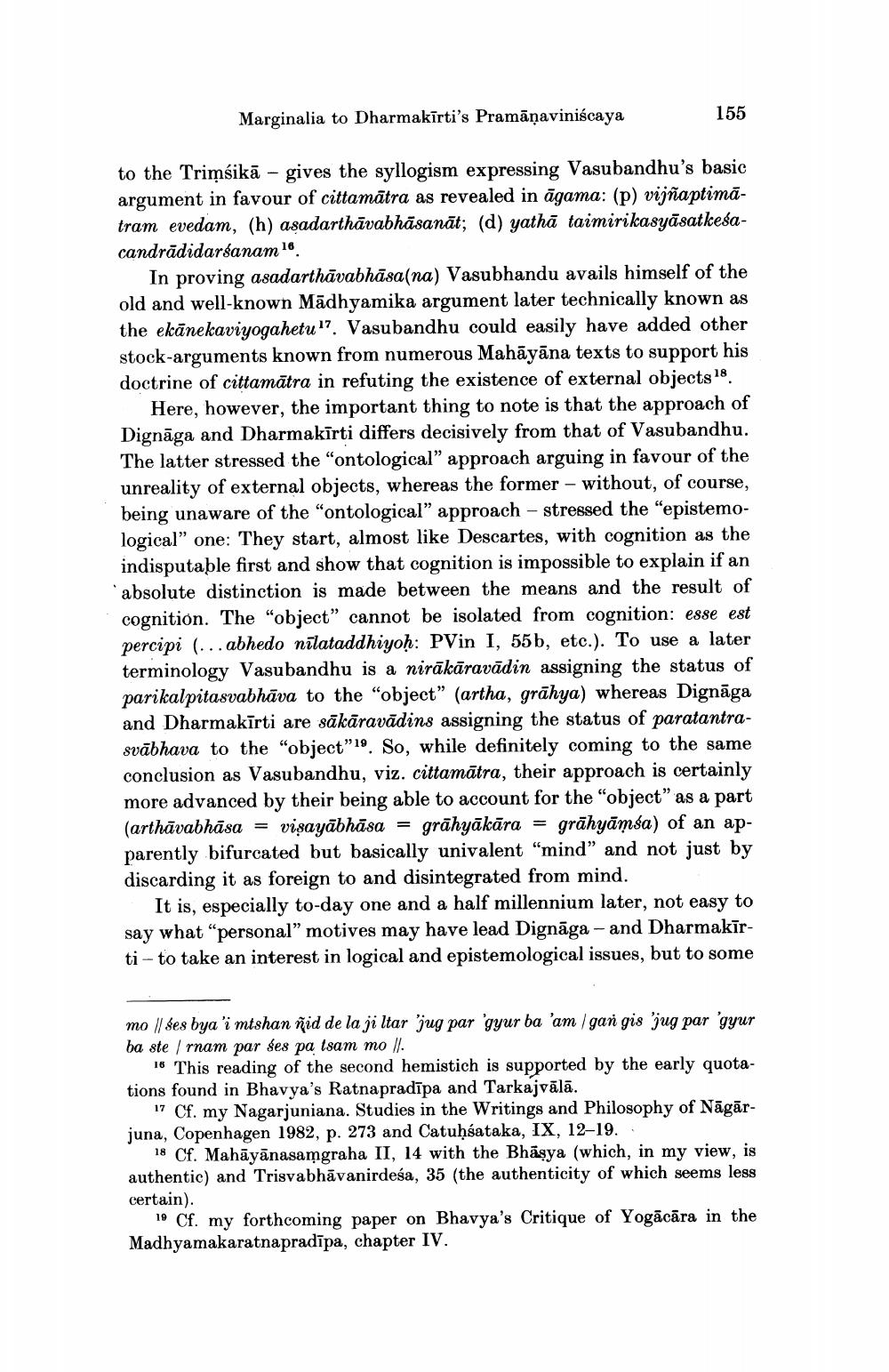Book Title: Marginalia To Dharmakirtis Pramanaviniscaya I II Author(s): Christian Lindtner Publisher: Christian Lindtner View full book textPage 7
________________ Marginalia to Dharmakīrti's Pramāņaviniscaya 155 to the Trimsikā - gives the syllogism expressing Vasubandhu's basic argument in favour of cittamātra as revealed in āgama: (p) vijñaptimatram evedam, (h) asadarthāvabhāsanāt; (d) yathā taimirikasyāsatkeśacandrādidarsanam 16. In proving asadarthāvabhāsa(na) Vasubhandu avails himself of the old and well-known Madhyamika argument later technically known as the ekānekaviyogahetu"7. Vasubandhu could easily have added other stock-arguments known from numerous Mahāyāna texts to support his doctrine of cittamātra in refuting the existence of external objects 18. Here, however, the important thing to note is that the approach of Dignāga and Dharmakīrti differs decisively from that of Vasubandhu. The latter stressed the "ontological approach arguing in favour of the unreality of external objects, whereas the former - without, of course, being unaware of the "ontological" approach - stressed the "epistemological" one: They start, almost like Descartes, with cognition as the indisputable first and show that cognition is impossible to explain if an absolute distinction is made between the means and the result of cognition. The "object" cannot be isolated from cognition: esse est percipi (... abhedo nīlataddhiyoḥ: PVin I, 55b, etc.). To use a later terminology Vasubandhu is a nirākāravādin assigning the status of parikalpitasvabhāva to the "object" (artha, grāhya) whereas Dignāga and Dharmakīrti are sākāravādins assigning the status of paratantrasvābhava to the "object"19. So, while definitely coming to the same conclusion as Vasubandhu, viz. cittamātra, their approach is certainly more advanced by their being able to account for the "object" as a part (arthāvabhāsa = visayābhāsa = grāhyākāra = grāhyāmša) of an apparently bifurcated but basically univalent "mind” and not just by discarding it as foreign to and disintegrated from mind. It is, especially to-day one and a half millennium later, not easy to say what personal” motives may have lead Dignāga - and Dharmakīrti - to take an interest in logical and epistemological issues, but to some mo // ses bya'i mtshan ñid de la ji ltar jug par 'gyur ba 'am /gan gis jug par 'gyur ba ste / rnam par ses pa tsam mo Il. 16 This reading of the second hemistich is supported by the early quotations found in Bhavya's Ratnapradīpa and Tarkajvālā. 17 Cf. my Nagarjuniana. Studies in the Writings and Philosophy of Nāgārjuna, Copenhagen 1982, p. 273 and Catuḥsataka, IX, 12-19. 18 Cf. Mahāyānasamgraha II, 14 with the Bhāsya (which, in my view, is authentic) and Trisvabhāvanirdesa, 35 (the authenticity of which seems less certain). 19 Cf. my forthcoming paper on Bhavya's Critique of Yogācāra in the Madhyamakaratnapradīpa, chapter IV.Page Navigation
1 ... 5 6 7 8 9 10 11 12 13 14 15 16 17 18 19 20 21 22 23 24 25 26 27
